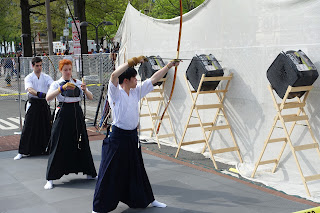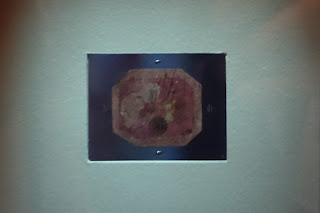Sakura Matsuri
Here in our small corner of the world...
This past Saturday the family and I took the Metro into Washington to check out the 59th Annual Sakura Matsuri さくら祭り Japanese Street Festival on Pennsylvania Avenue (between 3rd and 7th Streets). I'm happy to report a good time was had by all - even my wife didn't complain about the weather or the walking. After some morning rain, the sky had turned sunny as we arrived at the festival site:
There were a number of performances throughout the day, but without a doubt the best-received was that of the drummers and dancers from Tamagawa University 玉川大学ダンス・太鼓グループ in Machida 町田市, Tōkyō 東京都:
Numerous stalls lined both sides of the four blocks of Pennsylvania Avenue:
My daughter had her name rendered in katakana 片仮名 on a bookmark. I recently learned to my pleasant surprise that アンバー has been teaching herself how to read kana 仮名:
Amber was too shy to stop by and say hello even though she has taken part in several competitive tournaments at the National Go Center:
Shu-E busied herself with taking a lot of photos of the cosplayers コスプレ who turned out in large numbers for the festival:
Below are a few of her photos. I'm an admitted Japanophile, but I've never fallen for the siren song of anime アニメ, manga 漫画 and all the other elements of Japanese pop culture that seem to be fueling the record numbers of foreign visitors going to Japan in recent years (over 30 million in 2018, with more expected this year). It's all good, clean fun, but I wonder what the average Japanese person makes of it all. The country has a long, fascinating and complex history, not to mention a unique traditional culture, yet most young westerners are more into maid cafés メイド喫茶 and Dragon Ball Z どらごんぼーるZ. Why, in my day, I never felt the urge to dress up as Speed Racer 三船剛 - had I done so, I probably would've have had the crap beaten out of me. Then again, in my day, popular perceptions of Japan didn't extend much further than cars, electronics and "geisha girls", so things haven't really changed much:
Speaking of otaku おたく, my daughter was keen to check out the DVD's on sale, though in the end she decided not to buy anything:
Karuta かるた, a traditional Japanese playing card game:
I didn't know anything about this band, but any group that covers Stooges songs deserves a listen:
I've never been into the martial arts, but I did see a demonstration of kyūdō 弓道 once at Tokyo's notorious Yasukuni Shrine 靖国神社. Amber seemed particularly interested in this form of archery:
Speaking of my daughter, to her great relief her usual Sunday afternoon class in reading and writing traditional Chinese characters 繁體字 was taking a break. Unfortunately for her, I decided she should get out of the house and accompany me back into D.C. Our destination was located next to Washington's grandiose Union Station, a throwback to the glory days of American rail travel:
Amber took this shot of the sunlight shining through the glass panes:
That destination was the National Postal Museum, celebrating the age when people didn't transmit messages electronically:
The museum is part of the Smithsonian Institution (meaning admission is free!) and is housed in an impressive building that served as Washington, D.C.'s main post office from 1914 to 1986 (the museum itself opened in 1993):
The good news is that you don't have to be a philatelist to appreciate the rare and historic (not to mention valuable) stamps in the museum's collection:
The Inverted Jenny, the most prized error in the history of stamp collecting:
The writing on this piece of mail delivered via Pony Express reads "recovered from a mail stolen by the Indians in 1860". It eventually reached New York in 1862, by which time the Pony Express was no longer in service:
A postcard recovered from the wreckage of the Hindenburg (and delivered to its destination):
The quality of the photos isn't very good (my apologies) but the significance is clear (read below):
Me and Mr. ZIP, a memory from childhood:
An old mailbox from Taiwan (modern ones are green-colored):
One of the security guards on duty pointed out the tiles on the museum floor. Come on, you must see an envelope...:
...and a letter with a stamp on it, right?:
In addition to the stamp collection, the museum features changing exhibits related to the U.S. Postal Service. The one on the pilots who made the first mail runs by plane was sobering:
Another exhibit on the Postal Inspection Service was interesting. Among the displays was one of the mailboxes into which letters laced with Anthrax spores were deposited during the Anthrax attacks of September 2001:
My daughter poses with Benjamin Franklin, the first Postmaster General of the United States:
With the onset of the school spring break holidays, FSI has very generously allowed its students the option of taking one day of paid leave during the last two weeks of April so that parents may spend some time with their families. If, like me, the student is staying in temporary (i.e. subsidized) housing, taking a Monday or Friday off would involve having to pay rent for that extended weekend. Which is why I chose a Tuesday (today) to take a break from Amharic and force Amber to get outside and away from her various electronic devices. The plan was to visit the Bureau of Engraving and Printing, where our paper currency is designed. "The most glorified print shop in the world" is only open to the public on weekdays, and while entry is free, visitors are required to obtain tickets for a compulsory tour from a single ticket booth on Raoul Wallenberg Place. We arrived at the booth just after ten in the morning only to discover that all the tickets for the day had been distributed. So it was time for Plan B - the National Archives. Here tickets weren't required, but we did have to queue outside for more than thirty minutes before being allowed entry. The tourist season has apparently started, and there were a lot of student groups waiting to get into the Archives, including a disturbingly large number of cleancut Caucasian teens decked out in MAGA gear. The future of this country is a cause for concern:
Photography isn't permitted inside, so the following four photos have been copped from the official website. We immediately made our way to the Rotunda to join the crowds examining the Big Three Documents:
The Archives also hold one of only four copies of the Magna Carta (we had seen one a couple of years ago in Salisbury Cathedral). In addition, a special showing of the Emancipation Proclamation is being held until tomorrow, but the line to see it was too long so we gave it a pass. The rest of the National Archives is a mish-mash of archival-themed exhibits, some more interesting than others.
It was still early in the afternoon when we exited the Archives building, so I
Many of the artworks are on loan from the Palace Museum in Beijing:
Twelve-panel screen of Virtuous Empresses and Empresses Dowager in Successive Dynasties (1737):
The empresses and empresses dowager of the Qing Dynasty 清朝 were ethnically Manchus. Unlike the Han Chinese 汉族, Manchu women did not engage in the hideous practice of foot binding:
An Imperial Seal of Empress Xiaozhuang 孝莊文皇后 (1736):
A carved lacquer tray of "one hundred boys" at play:
A painting of the Dragon Boat Festival 端午節 from the Yongzheng period (1723-35):
These sacred texts from Tibet were commissioned by the Qianlong Emperor 乾隆帝 to commemorate the 80th birthday of his mother, the Empress Dowager Chongqing:
The same emperor also had this magnificent stupa made to hold a clipping of his mother's hair after her death:
The exhibit at the Stackler contains some fascinating artworks and goes a long way toward showing that there was more to the imperial women of the Qing dynasty than the infamous Empress Dowager Cixi 慈禧太后. Amber was less than impressed, however. She's at that stage in life where she's too old to be easily impressed by beautiful objects, but too young to have an understanding of the role of genealogy in helping to define who she is as a person (the National Archives has a display on the notorious Chinese Exclusion Act of 1882, but it didn't seem to bother her much). I figure that around her first or second year in college she will "discover" how Taiwanese she actually is, in the same way her father turned "British" when he was at university!
Meanwhile, back in the world of language acquisition, the struggles continue. Sentences that are well-formed in the mind come out garbled as verbs, and their conjugations that had seemingly been acquired suddenly vanish when transformed into changes in surrounding air pressures. In other words, the same situation as always. At least my Amharic class was able to leave the not-so-friendly confines of FSI and go on a field trip to the Voice of America headquarters in the Wilbur J. Cohen Federal Building on the day following April Fool's. After observing a panel discussion on "Ethiopia's Reform: The Free Media in a Budding Democracy", we were introduced to the staff in the Amharic section, then given a tour of the VOA's facilities, including its radio and TV studios:
With VOA French to Africa broadcaster Roger Muntu:
And of course our field trip ended with a late lunch at one of D.C.'s many Ethiopian restaurants (in this case, the Queen of Sheba). If I've learned anything from studying Amharic, it's that I prefer the taste of Habesha Beer ሐበሻ ቢራ to that of St. George ቅዱስ ጊዮርጊስ ቢራ (pictured below):
And in local news, a couple of Saturdays ago I took Amber to the Cherry Hill Farmhouse Ice Cream Social, marking the season opening of the historic 1845 farmhouse and neighboring barn:
When I remarked to my daughter that I was surprised that Falls Church still had a functioning blacksmith as late as 1946, she replied that she was just as stunned to hear that people were driving cars as far back as the 1940's!:
The ice cream was free and the little ones reached back in time to engage in some hoop rolling:
Afterward the two of us had lunch at a local Japanese restaurant. The eatery shall remain nameless for the time being as I didn't think the rāmen ラーメン was all that good (the broth being too thick), but the wall decorations were cool and Amber liked the manga provided for the customers' enjoyment while waiting for their meals to arrive at their tables (just as you find at many cafés and restaurants in Japan):
And so another hanami 花見 season is behind us, as spring moves into high gear and summer gets closer. I can think of no more apropos place to appreciate the transient beauty of the cherry blossoms than in the local cemetery:
And if you think I'm being facetious, I'll leave you with this video from YouTube, taken in Tokyo's beautiful Aoyama Cemetery 青山霊園:





















































































No comments:
Post a Comment